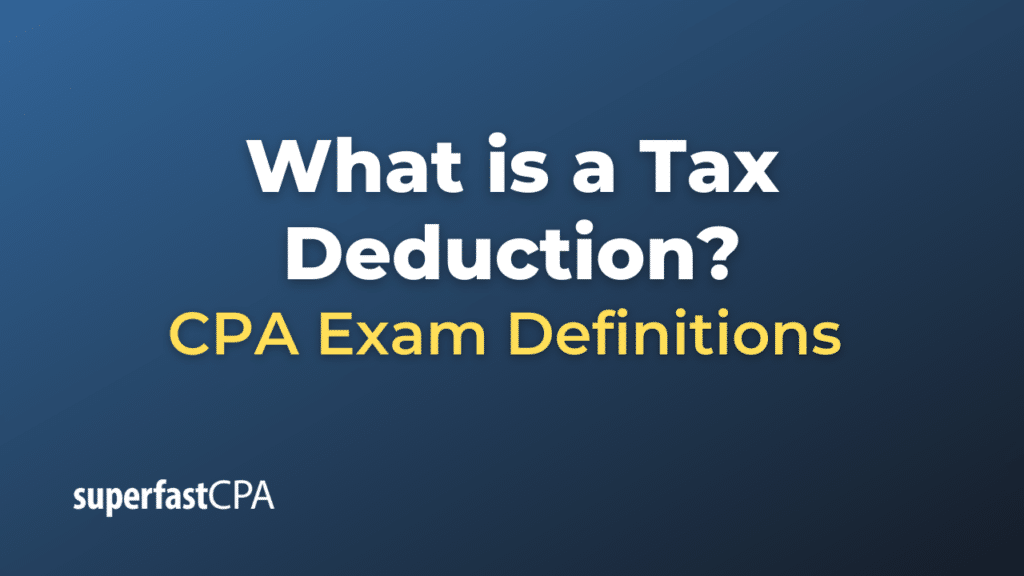Tax Deduction
A tax deduction is a reduction in the amount of income that is used to calculate how much tax an individual or business owes to the government. In other words, it decreases the taxpayer’s taxable income, and therefore, reduces the total tax liability. Tax deductions are a tool used by governments to encourage certain behaviors or to provide relief for specific expenditures.
Here are some essential points about tax deductions:
- Nature: Tax deductions differ from tax credits. While deductions reduce the taxable income, tax credits directly reduce the amount of tax owed.
- Types:
- Above-the-line deductions: These are subtractions from gross income that result in an adjusted gross income (AGI). Examples include educator expenses or student loan interest.
- Below-the-line deductions: After calculating the AGI, taxpayers can choose to itemize their deductions (like mortgage interest, charitable contributions, and medical expenses) or take the standard deduction, which is a fixed amount that varies based on filing status.
- Purpose: Governments often introduce tax deductions to incentivize or reward specific behaviors. For instance, deductions for mortgage interest or real estate taxes might encourage homeownership, while deductions for charitable contributions incentivize charitable giving.
- Eligibility & Limitations: Not all expenses are deductible, and many have specific criteria or caps. For example, in certain tax systems, medical expenses might be deductible only if they exceed a specific percentage of the taxpayer’s adjusted gross income.
- Effect: Tax deductions reduce the taxpayer’s taxable income. As a result, the tax liability is calculated on a lower amount. However, the value of a deduction is determined by the taxpayer’s marginal tax rate. If someone is in the 25% tax bracket, a $1,000 deduction will save them $250 in taxes.
- Documentation: It’s essential for taxpayers to maintain proper records and receipts for all potential deductions to provide evidence of their claims if requested by tax authorities.
In summary, a tax deduction is a provision that allows taxpayers to reduce their taxable income based on specific expenses or allowances, which, in turn, lowers their overall tax liability.
Example of a Tax Deduction
Let’s use a hypothetical example to illustrate how a tax deduction works:
Scenario:
Meet Alex, a single individual with a salaried job. In 2022, he earned $60,000. Throughout the year, Alex had several expenses:
- Mortgage interest: $4,000
- Charitable donations: $2,000
- Student loan interest: $1,000
Alex lives in a country where:
- The standard deduction is $12,000 for a single filer.
- Mortgage interest, charitable donations, and student loan interest are all tax-deductible.
Tax Deduction Breakdown:
- Mortgage Interest:
- Alex can deduct the $4,000 he paid in mortgage interest from his taxable income.
- Charitable Donations:
- Alex donated $2,000 to a qualifying charitable organization, which is deductible.
- Student Loan Interest:
- Alex can deduct the $1,000 he paid in student loan interest.
Total Deductions:
- Mortgage interest: $4,000
- Charitable donations: $2,000
- Student loan interest: $1,000
- Total from itemized deductions: $7,000
Given the options, Alex must decide whether to take his itemized deductions totaling $7,000 or the standard deduction of $12,000. He should choose the larger amount to minimize his taxable income. Thus, Alex opts for the standard deduction.
Taxable Income Calculation:
Original Income: $60,000
Standard Deduction: – $12,000
Taxable Income: $48,000
If Alex did not take any deductions, his taxable income would be the full $60,000. But with the standard deduction, his taxable income is reduced to $48,000.
This example demonstrates how tax deductions, whether itemized or standard, can effectively reduce a taxpayer’s taxable income and potentially the amount of tax owed.













